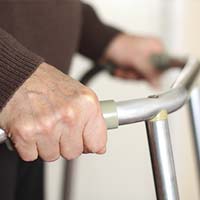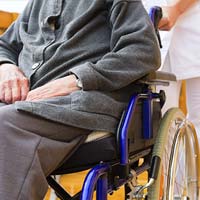It is not easy to make the decision to entrust the care of an elderly loved one to strangers. It requires not only diligence and research, but, most importantly, trust.
Even after thorough vetting, the decision to trust certain elder-care “professionals” can turn into a nightmare for our loved ones and a life of regret for the decision-makers, as in most cases, the ones we seek care for cared for us first.
Types of Elder Abuse
 According to the National Council on Aging (NCOA), elder abuse is defined as and may include, “physical abuse, emotional abuse, sexual abuse, exploitation, neglect, and abandonment.”
According to the National Council on Aging (NCOA), elder abuse is defined as and may include, “physical abuse, emotional abuse, sexual abuse, exploitation, neglect, and abandonment.”
“Perpetrators include children, other family members, and spouses—as well as staff at nursing homes, assisted living, and other facilities.” NCOA breaks down the abuse into categories, and elaborates:
- Physical abuse — physical pain or injury upon an older adult.
- Sexual abuse — touching, fondling, intercourse, or any other sexual activity with an older adult, when the older adult is unable to understand, unwilling to consent, threatened, or physically forced.
- Emotional abuse — verbal assaults, threats of abuse, harassment, or intimidation.
- Confinement — restraining or isolating an older adult, other than for medical reasons.
- Passive neglect — a caregiver’s failure to provide an older adult with life’s necessities, including, but not limited to, food, clothing, shelter, or medical care.
- Willful deprivation — denying an older adult medication, medical care, shelter, food, a therapeutic device, or other physical assistance, and exposing that person to the risk of physical, mental, or emotional harm—except when the older, competent adult has expressed a desire to go without such care.
- Financial exploitation — the misuse or withholding of an older adult’s resources by another. NCOA has more information
What to Look For
At times, elder abuse is difficult to recognize. Helpguide.org, a guide collaborating with Harvard Health that is devoted to mental, emotional and social health, has compiled a list of indicators that help identify some of the warning signs.
Physical Elder Abuse Warning Signs
Emotional Elder Abuse Warning Signs
Sexual Elder Abuse Warning Signs
Elder Neglect by Caregivers or Self-Neglect Warning Signs
Financial Exploitation Warning Signs
Healthcare Fraud and Abuse Warning Signs
Physical Elder Abuse Warning Signs
-
- Unexplained signs of injury, such as bruises, welts, or scars, especially if they appear symmetrically on two sides of the body
- Broken bones, sprains, or dislocations
- Report of drug overdose or apparent failure to take medication regularly (a prescription has more remaining than it should)
- Broken eyeglasses or frames
- Signs of being restrained, such as rope marks on wrists
- Caregiver’s refusal to allow you to see the elder alone
Emotional Elder Abuse Warning Signs
In addition to the general signs above, indications of emotional elder abuse include:
- Threatening, belittling, or controlling caregiver behavior that you witness
- Behavior from the elder that mimics dementia, such as rocking, sucking, or mumbling to oneself
Sexual Elder Abuse Warning Signs
- Bruises around breasts or genitals
- Unexplained vaginal or anal bleeding
- Torn, stained, or bloody underclothing
Elder Neglect by Caregivers or Self-Neglect Warning Signs
-
- Unusual weight loss, malnutrition, dehydration
- Untreated physical problems, such as bed sores
- Unsanitary living conditions: dirt, bugs, soiled bedding and clothes
- Being left dirty or unbathed
- Unsuitable clothing or covering for the weather
- Unsafe living conditions (no heat or running water; faulty electrical wiring, other fire hazards)
- Unsafe pathways, unkempt hallways
- Desertion of the elder at a public place
Financial Exploitation Warning Signs
-
- Significant withdrawals from the elder’s accounts
- Sudden changes in the elder’s financial condition
- Items or cash missing from the senior’s household
- Suspicious changes in wills, power of attorney, titles, and policies
- Addition of names to the senior’s signature card
- Unpaid bills or lack of medical care, although the elder has enough money to pay for them
- Financial activity the senior couldn’t have done, such as an ATM withdrawal when the account holder is bedridden
- Unnecessary services, goods, or subscriptions
Healthcare Fraud and Abuse Warning Signs
- Duplicate billings for the same medical service or device
- Evidence of overmedication or undermedication
- Evidence of inadequate care when bills are paid in full
- Problems with the care facility: poorly trained, poorly paid, or insufficient staff; crowding; inadequate responses to questions about care
For more information, see this Help Guide.
Elder Abuse Not Uncommon
Cases of elder abuse, especially in long-term care facilities, have become more common. The National Center for Elder Abuse (NCEA) estimates that one in 10 individuals 60 years of age or older have been exposed to some sort of abuse; the numbers may range as high 5 million individuals overall. More frightening, NCEA suggests that only one in fourteen cases of abuse is ever reported.
Abuse in Skilled-Nursing Facilities / Nursing Homes
 Skilled nursing facilities and nursing homes are similar in that they are live-in facilities for individuals who can no longer take care of themselves. The degree of assistance given depends upon the home and the condition of the patient. It ranges from complete care in nursing homes to varying levels of independence at skilled-nursing facilities. Face the Facts, a project of George Washington University, estimates that more than 1.3 million Americans live in nursing homes.
Skilled nursing facilities and nursing homes are similar in that they are live-in facilities for individuals who can no longer take care of themselves. The degree of assistance given depends upon the home and the condition of the patient. It ranges from complete care in nursing homes to varying levels of independence at skilled-nursing facilities. Face the Facts, a project of George Washington University, estimates that more than 1.3 million Americans live in nursing homes.
These facilities are federally regulated and are expected to meet certain standards, but without full-time family supervision, those with bad intentions are able to get away with abusive or negligent care. According to Nursinghomeabuseguide.org, more than two million cases of elder abuse are reported each year.
- Between 1999 and 2001, almost one-third of all nursing home facilities were cited for violations of federal standards that could cause harm or that did harm elderly residents of those facilities.
- Nearly 10% of those homes had violations that posed a risk of serious injury or death or that did cause deaths of elderly residents.
- More than 40% of nursing home residents have reported abuse, and more than 90% report that they or another resident of the facility have been neglected.
- Research from 2010 indicates that up to half of all nursing home attendants have admitted abusing or neglecting elderly patients.
- More than half of all Certified Nursing Assistants (CAN’s) in elder care facilities have admitted verbally abusing, yelling at, and using foul language with elderly residents of care facilities.
Abuse in Assisted Living or Retirement Homes and Senior Living Areas
These homes are for relatively independent seniors. Senior living communities usually have a minimum age requirement and offer communal outings, meals and other amenities. Assisted living facilities serve residents who are mostly independent, but need some supervision for health or other reasons. These are a step below nursing or long-term-care facilities. The opportunities for abuse in these facilities still exists, but the statistics show prevalence of abuse is not as severe.
Abuse from Home Health Care, In-Home Care or Home Health Agencies
These situations differ in their level of care, based primarily on the condition of the individual. Generally, the individual lives at home and can have assistance ranging from occasional visits to around-the-clock care. As with the other types of care, opportunities for elder abuse still exist, especially for those whose needs are great.
Nursing Homes Near Tucson
Medicare has rated nursing 21 nursing home facilities located within 25 miles of Tucson. The results show a wide range in care. Five facilities received a below average rating and eight received average ratings, while five facilities were rated much above average and three were above average.
Those Tucson, AZ nursing homes with the lowest ratings from Medicare include:
- Villa Maria Care Center: 4310 East Grant Road, Tucson, AZ 85712
- Santa Rosa Care Center: 1650 North Santa Rosa Avenue, Tucson, AZ 85712
- The Health Care Center-Forum Tucson: 2500 North Rosemont Boulevard, Tucson, AZ 85712
- Pueblo Springs Rehabilitation Center: 5545 East Lee Street, Tucson, AZ 85712
- Foothills Rehabilitation Center: 2250 North Craycroft Road, Tucson, AZ 85712
- Villa Campana Rehabilitation Hospital LLC: 6651 East Carondelet Drive, Tucson, AZ 85710
The full rankings are available here.
Help for You and Your Family
If you suspect that your loved one has been the victim of elder abuse, you have legal options. Nursing home owners, administrators, common workers, medical personnel and anyone associated with the abuse may be held liable. Filing an elder abuse lawsuit may lead to legal compensation for victims and their families, but it may also help make a change in the care given others in the future.
The first step is to contact an attorney that is familiar with the local system and is experienced in protecting the rights of elders. The attorneys at Khalidi Law Firm, PLLC have the experience and the resources to help you gain full and fair compensation if your elderly loved one has been the victim of physical, emotional or financial abuse at the hands of an Arizona caregiver.
Based in downtown Tucson, Arizona’s Barrio Historico, our team has litigated elder abuse cases and a wide range of other personal injury cases since 1994. We’re here to help you and your family.



